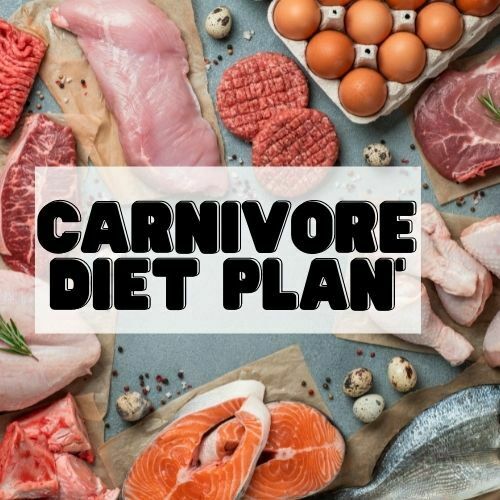Of course, eating a load of bacon and chicken might seem like a dream for all meat lovers. But are you filling your plate with meat as part of the “carnivore diet plan”? The internet is overwhelmed with interesting carnivore diet before and after pictures and reviews of the plan, which made them ask what is the carnivore diet. and what does a carnivore eat?
Carnivore definition
The official definition of the Carnivore diet according to Merriam-Webster, is “an animal that mainly or only feeds on the animal.
As its name suggests, the carnivorous diet is a whole-meat diet consisting almost entirely of animal products such as red meat, fish, and poultry. Some other products such as eggs and dairy products can also be allowed, although some are advised to restrict foods that are high in lactose, such as milk, cheese, and yogurt.
Fruits and vegetables are prohibited on this meat-only diet, along with other foods such as nuts, seeds, and grains.
The diet is based on the idea that our ancestors consumed limited amounts of carbohydrates and consumed a diet consisting of meat instead.
However, unlike other low-carb diets, such as the Paleo diet, the carnivorous meat system eliminates foods that contain carbohydrates.
The differences between herbivores, omnivore carnivore:
As we mentioned before carnivore meaning is that it feeds on animals mainly, so any animal feeds on herbs is called an herbivore and an omnivore feeds on both animals and herbs.
What is the Carnivore diet’s major drawback?
There is little or no noticeable dietetics to support this plan, but the diet is incredibly restricted, difficult to follow, and likely to lead to nutritional deficiencies in the long run.
The Carnivore Diet’s major drawbacks include:
- Lack of Nutritional Variety: The diet excludes all plant-based foods, which may lead to deficiencies in essential nutrients like fiber, vitamins (e.g., vitamin C), and antioxidants.
- High Saturated Fat: A heavy reliance on animal-based foods can result in consuming large amounts of saturated fats, which may increase cholesterol levels and the risk of heart disease.
- Digestive Issues: The absence of fiber can lead to constipation and other digestive problems due to low gut health diversity.
- Potential for Nutrient Deficiencies: The lack of fruits, vegetables, and whole grains may result in insufficient intake of important nutrients such as potassium, magnesium, and folate.
- Social and Practical Challenges: Following such a restrictive diet can be difficult in social settings or when eating out, making it less sustainable for some individuals.
- Lack of Long-Term Research: There is limited scientific research on the long-term health effects of following the Carnivore Diet, especially regarding chronic diseases and overall mortality.
- Risk of Kidney Strain: The high protein intake may put a strain on the kidneys, especially for individuals with pre-existing kidney conditions.
- Possible Mental Health Impact: The restrictive nature of the diet can lead to feelings of deprivation, which may affect mood, mental health, and eating behaviors.
What does a Carnivore eat?
Compared to other eating patterns and diets, the diet menu for carnivores is quite clear. Meat, fish, poultry, eggs, and some dairy products are permitted, and most other foods should be eliminated.
Here are some of the best foods that can be included as part of the carnivorous meat diet shopping list:
Meat
- Beef
- Mutton
- veal
- bison
- bowels
Seafood
- Salmon
- Tuna
- Mackerel
- Anchovies
- cod
Poultry
- chickens
- Turkey
- Goose
- Duck
- eggs
- Egg eggs
Dairy products
- Low-lactose foods such as hard cheeses and butter
Drinks
- water
- Bone broth
Here are some foods to avoid on carnivore diet plans:
fruits
- Apples
- the banana
- Orange
- Berries
- Pear
- Peach
Vegetables
- Broccoli
- Cauliflower
- Spinach
- Turnip
- Courgettes
- tomatoes
- Pepper
Legumes
- Chickpeas
- Kidney pills
- Black beans
- Lentils
- Pinto beans
Nuts
- Almonds
- Nut
- Macadamia nuts
- Pecans
- Cashew nuts
- Pistachios
Seeds
- Chia seeds
- Flaxseed
- Yurt seeds
- Hemp seeds
- sunflower seeds
Grain
- Marigolds
- Quinoa
- Wheat
- Wheat
- Black
- the rice
- Oats
- barley
- the pasta
Dairy products
High-lactose foods like milk, yogurt, and soft cheese
Processed foods
- Chips
- Crackers
- Candy
- Rest meals
- Fast food
Drinks
- Tea
- Coffee
- Sports drinks
- Soft drinks
- Energy Drinks
Sugars
- Table sugar
- Brown sugar
- Honey
- Maple syrup
Curious, what does a carnivore diet menu on breakfast look like, and what meals you can enjoy as part of the diet?
7 Days Carnivore Diet Meal Plan
Check out this 7-day sample carnivore meal plan, plus some simple carnivore diet recipes to help you get started:
Day 1
- Breakfast: 4 scrambled eggs cooked in butter, topped with shredded cheese
- Lunch: Grilled ribeye steak with a side of beef bone marrow
- Dinner: Ground beef patties with a side of beef tallow
Day 2
- Breakfast: Omelet with cheese, cooked in tallow or duck fat
- Lunch: Pan-seared lamb chops with a side of bone broth
- Dinner: Roast chicken thighs with skin
Day 3
- Breakfast: 3 poached eggs and a few slices of smoked salmon
- Lunch: Duck breast with crispy skin
- Dinner: Grilled beef liver and buttered ribeye steak
Day 4
- Breakfast: Soft-boiled eggs with slices of beef jerky
- Lunch: Roast turkey drumsticks with skin
- Dinner: Baked salmon fillet with a side of shrimp cooked in butter
Day 5
- Breakfast: Fried eggs with diced beef sausage (or beef breakfast patties)
- Lunch: Ground beef and liver mix (50/50) with added bone marrow
- Dinner: Seared ribeye with a side of grilled scallops
Day 6
- Breakfast: Cheese-stuffed omelet with sliced brisket
- Lunch: Baked cod or haddock with melted butter on top
- Dinner: Lamb shoulder chops with a side of bone marrow
Day 7
- Breakfast: Scrambled eggs with smoked salmon and extra butter
- Lunch: Chicken wings cooked with skin on
- Dinner: Grilled T-bone steak with a side of beef liver pâté
Benefits of the Carnivore diet

1- It may promote weight loss
One of the highest benefits of a carnivorous diet is that it removes high-carb, highly processed ingredients, many of which are also in calories. Reducing your calorie intake, such as chips, candy, biscuits, and cakes, can help boost weight loss.
Although research on a carnivorous diet is limited, many studies have found that low-carb diets can be effective for losing weight.
For example, a 2013 review in the British Journal of Nutrition showed that a low-carb diet was able to increase long-term weight loss in participants compared to a low-fat diet, suggesting that lowering carbohydrates could be a useful strategy to combat obesity.
2- Reduced sugar diet
Plenty of foods restricted to the carnivore diet plan are rich in added sugar, including sugar-sweetened beverages, baked goods, sweets, and sweets.
Added sugar can have harmful effects on almost every aspect of health, as some research links the consumption of added sugar to an increased risk of obesity, heart disease, liver problems, and even cancer.
Eliminating these foods from your diet may lower your risk of chronic disease to support overall health.
3- High in protein
Meat, fish, and poultry are the main ingredients of a carnivorous diet, all loaded with protein.
Protein plays a major role in tissue repair, muscle building, growth, and immune function. Deficiency can have severe consequences and may lead to symptoms such as weakness, vascular problems, stunted growth, and anemia.
Protein-rich diets have also been shown to promote weight loss and reduce levels of the hormone ghrelin, the hormone that stimulates hunger, to help curb cravings and maintain your appetite.
Risks and side effects of the carnivore diet plan
Currently, no research has been done to assess the long-term effects of a carnivore diet. Therefore, it is difficult to determine just how much eating meat and eggs will affect your health and whether or not following a meat-eating diet leads to any real benefits.
However, the Carnivore diet plan eliminates many important food groups that provide essential nutrients, including a group of vitamins and minerals. This can increase the risk of nutritional deficiency, which can lead to serious side effects such as low energy levels, brain fog, and poor immune functions.
The Carnivore diet plan also contains low fiber, which is an important compound that promotes digestive health, regularity, heart health, and more.
On the other hand, the carnivore diet plan contains high dietary cholesterol, saturated fat, and sodium, which doesn’t go as a healthy diet.
It may also contain high amounts of red meat and processed meats, which have been linked to an increased risk of colorectal cancer.
In general, a carnivorous diet is very restrictive and eliminates many important food groups, including fruits and vegetables. Therefore, it should not be followed in the long run, as it can increase the risk of undernutrition and health problems.
Contraindications
1- Because the diet is very restricted, it is not suitable for children, pregnant or lactating women.
2- It is also not recommended for those with certain health conditions, including diabetes or kidney disease.
However, if you have any basic health conditions, consult your doctor before changing your diet.
3- Because it is high in fat and low in fiber, the plan may cause digestive problems for some people. Similar to “Keto Flu”, which is a common side effect of high-fat diets like Keto, it can cause loose stools or excess feces in the stool and is not a recommended diet for diarrhea. Conversely, constipation may also be due to less fiber.
Other possible side effects of the Carnivore diet include:
- Increased cravings
- Low energy levels
- Bloating
- Focus is weak
- nausea
- Irritability
- Headache
Carnivore Diet vs. keto diet
The ketogenic diet is another popular diet plan that involves restricting high-carb foods and added sugar.
However, unlike the carnivore diet, the keto diet allows limited amounts of high-fiber low-carb fiber such as non-starchy vegetables and low-sugar fruits, as long as they are proportional to the daily carbohydrate allocation.
While the carnivore diet plan consists almost entirely of protein foods, the ketogenic diet only encourages moderate protein consumption. Instead of that.
